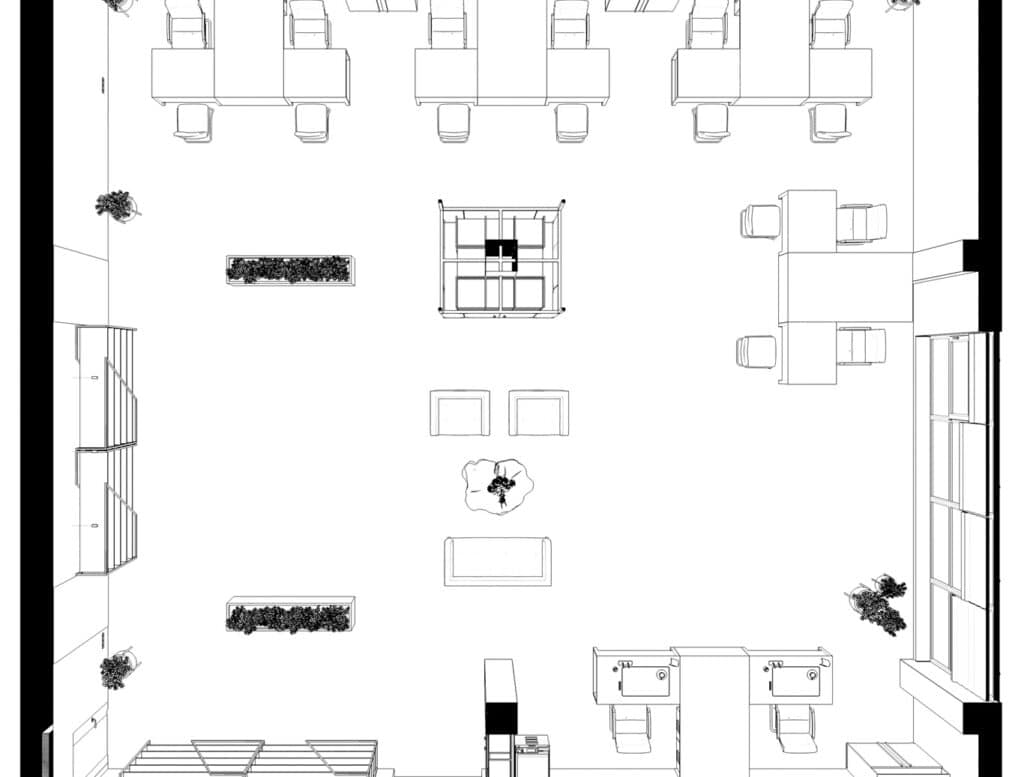Team meetings are one of the most powerful tools a business can use to stay connected, focused, and productive. Whether it’s a quick catch-up, a weekly staff meeting, or a monthly strategy session, an effective team meeting helps people share ideas, align goals, and strengthen relationships. In today’s hybrid world, where in-person meetings often blend with virtual meetings, getting them right is a vital part of modern leadership.
Key takeaways from this article
- Discover the 10 clear benefits that team meetings give you, from stronger relationships to better decision-making.
- Learn how to run effective team meetings that keep everyone on the same page.
- Explore best practices for choosing formats, setting a clear agenda, and assigning action items.
- See why balanced, distraction-free collaborative workspaces like office pods can elevate your meeting quality.
- Find out how follow-ups and open discussions turn meetings into long-term business success.

10 Key Benefits of Team Meetings
Regular team meetings are about far more than exchanging updates. Done well, meetings provide many benefits. They can help build relationships, improve communication and speed decision making. They support inclusivity, creativity and team alignment. They can make people feel better and work more productively, whilst also strengthening collaboration and helping managers to spot future improvements. Here are the top ten benefits — and how to achieve them.
1. They Build Stronger Relationships Among Team Members
One of the greatest benefits of team meetings is how they help build stronger relationships. When teams meet face to face, people read body language, build trust, and develop empathy — all key to effective collaboration. In-person meetings or hybrid sessions create personal interaction that makes team members feel valued and connected. The result is stronger relationships that extend beyond the meeting room and into everyday teamwork.
2. They Encourage Clear and Effective Communication
Team meetings provide a platform for open communication. They make sure not everyone is working in isolation or interpreting things the same way incorrectly. Through discussion, visual aids, and free-flowing exchange, participants can clarify what’s been discussed, avoid confusion, and ensure everyone shares the same goal. Research from Harvard Business Review shows that structured conversations significantly reduce misunderstandings and help teams collaborate more effectively.
3. They Facilitate Better and Faster Decision-Making
In an effective team meeting, the combination of multiple perspectives allows for faster and better decision making. Instead of waiting for endless email threads, team members can exchange ideas live and reach consensus quickly. Whether the meeting is virtual or in person, these moments of collective clarity drive projects forward — making meetings a vital role in organisational success.
4. They Promote Inclusion and Equal Participation
An inclusive meeting ensures that everyone has a voice. Effective team meetings are structured so that all participants can contribute — not just the loudest speakers. With a clear agenda and a supportive team leader, employees feel confident to speak up, share ideas, and influence outcomes. This inclusive approach helps build leadership skills across the whole team and improves overall morale.
5. They Spark Innovation, Creative Thinking and Problem Solving
Meetings provide the perfect space for creativity. Brainstorming sessions and team building activities let team members contribute fresh ideas without judgement. When the environment feels open and collaborative, innovation flourishes. Sticky notes, whiteboards, and digital collaboration tools can help teams visualise thoughts — creating a positive impact on problem solving and long-term business growth.
6. They Align Teams on Goals and Priorities
Team meetings ensure that everyone is on the same page and working toward the same goal. Whether the discussion focuses on a project milestone or department update, it’s where priorities get clarified and next steps agreed. Regular team meetings prevent duplication of effort and keep the whole team aligned, making progress visible and measurable through meeting minutes and follow up actions.
7. They Improve Employee Engagement and Morale
Employee engagement increases when people feel heard, informed, and involved. Effective team meetings help employees feel connected to the company’s vision and valued for their input. When leaders use these sessions to celebrate success or recognise effort, motivation rises. The result? Teams with higher engagement, stronger relationships, and a shared sense of purpose that directly benefits the organisation.
8. They Boost Team Productivity and Efficiency
When meetings are run with a clear agenda and a focus on outcomes, they streamline workflows. Teams can quickly identify blockers, allocate resources, and plan solutions — ensuring everyone uses meeting time efficiently. According to Forbes, businesses that hold focused, well-structured meetings see measurable improvements in team productivity. Effective meeting practices turn discussions into progress by producing concrete action items. The key is to keep meetings purposeful so employees get the most value from every session.
9. They Strengthen Collaboration Across Departments
Cross-functional meetings bring together people who don’t usually interact. They encourage knowledge sharing and collaboration across teams. These sessions help break down silos and promote understanding between departments — marketing learns from sales, operations learns from finance, and everyone benefits. Virtual meetings are especially useful for bringing geographically dispersed participants together in one conversation.
10. They Help Managers Identify Challenges and Blind Spots
Finally, one of the less obvious but most valuable benefits of team meetings is the ability to surface issues early. A good team leader listens for patterns in what’s discussed — missed deadlines, unclear roles, or communication breakdowns — and acts before problems grow. Follow up meetings ensure these insights turn into action items, supporting ongoing improvement and organisational health.

Best Practices for Effective Team Meetings
Knowing the benefits is one thing — achieving them consistently is another. By addressing issues such as agendas, participant choices, formats, feddback loops and follow-ups, you can make sure your meetings deliver real value every time.
Set a Clear Agenda and Objectives
Every effective team meeting begins with a clear agenda. This simple step sets expectations and ensures all participants arrive prepared. Outline discussion points, assign time slots, and highlight desired outcomes in advance. A structured meeting keeps conversation focused, prevents digressions, and makes it easier to record meeting minutes and assign follow up actions later.
Invite Only the Right Participants
Not everyone needs to be in every meeting. Smaller, targeted groups often create more productive discussions. The best staff meetings include only those team members who can contribute to the topic, make decisions, or act on outcomes. This approach respects employees’ time and maintains engagement. It also keeps the whole team focused on delivering tangible results rather than endless conversation.
Choose the Best Meeting Format
Selecting the right format is critical. In-person meetings work best for sensitive discussions or creative sessions where body language and personal interaction matter. Virtual meetings, by contrast, save time and make it easy for remote teams to connect via platforms such as Microsoft Teams. Some organisations find hybrid meetings combine the best of both worlds. For distraction-free in-person discussions, Persy Booths offers soundproof meeting rooms that help maintain focus without the cost or complexity of full renovations.
Encourage Active Participation and Feedback
A meeting only works if people are involved. Effective team leaders create space for everyone to speak, ask questions, and offer feedback. Encourage open discussions, use visual aids to clarify points, and summarise what’s been discussed to confirm understanding. When team members feel listened to and valued, their participation strengthens team cohesion and contributes to better decision making overall.
Assign Action Items and Follow-Ups
After each meeting, summarise action items clearly — who will do what, by when. Follow up sessions ensure accountability and keep progress visible. Without this step, even the most inspiring meeting can lose momentum. Using shared digital tools or sticky notes in the meeting room can help teams track updates easily. This structured follow up process transforms conversation into measurable success.and makes it easier to record meeting minutes and assign follow up actions later.
Invite Only the Right Participants
Not everyone needs to be in every meeting. Smaller, targeted groups often create more productive discussions. The best staff meetings include only those team members who can contribute to the topic, make decisions, or act on outcomes. This approach respects employees’ time and maintains engagement. It also keeps the whole team focused on delivering tangible results rather than endless conversation.
Choose the Best Meeting Format
Selecting the right format is critical. In-person meetings work best for sensitive discussions or creative sessions where body language and personal interaction matter. Virtual meetings, by contrast, save time and make it easy for remote teams to connect via platforms such as Microsoft Teams. Some organisations find hybrid meetings combine the best of both worlds. For distraction-free in-person discussions, Persy Booths offers soundproof meeting rooms that help maintain focus without the cost or complexity of full renovations.
Encourage Active Participation and Feedback
A meeting only works if people are involved. Effective team leaders create space for everyone to speak, ask questions, and offer feedback. Encourage open discussions, use visual aids to clarify points, and summarise what’s been discussed to confirm understanding. When team members feel listened to and valued, their participation strengthens team cohesion and contributes to better decision making overall.
Assign Action Items and Follow-Ups
After each meeting, summarise action items clearly — who will do what, by when. Follow up sessions ensure accountability and keep progress visible. Without this step, even the most inspiring meeting can lose momentum. Using shared digital tools or sticky notes in the meeting room can help teams track updates easily. This structured follow up process transforms conversation into measurable success.

Conclusion: Elevate Collaboration with Better Meetings
The benefits of team meetings are wide-ranging — from stronger relationships to sharper decision making and improved employee engagement. But meetings only deliver these benefits when they’re well-planned, inclusive, and focused on action.
Creating the right environment plays a vital role too. Distraction-free spaces help participants concentrate, contribute, and collaborate. That’s where Persy Booths comes in — offering practical, high-quality office pods that strike the perfect balance between performance and cost. If you are thinking of investing in soundroof booths or pods, bear in mind that buying direct from manufacturers like Persy Booths ensures you get not only the best value, but also friendly advice and fast delivery with minimum hassle.
When meetings are well-run and well-designed, they don’t just share information — they build the foundation for long-term success.







.avif)


.webp)
.webp)